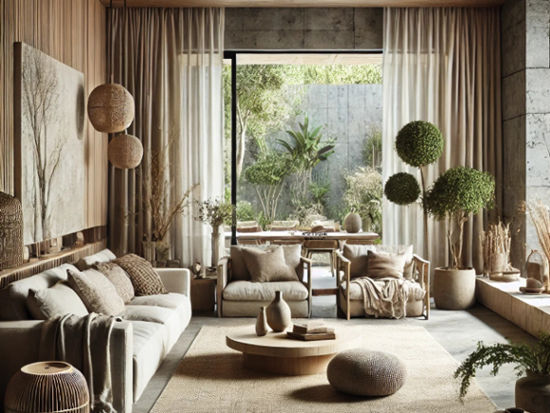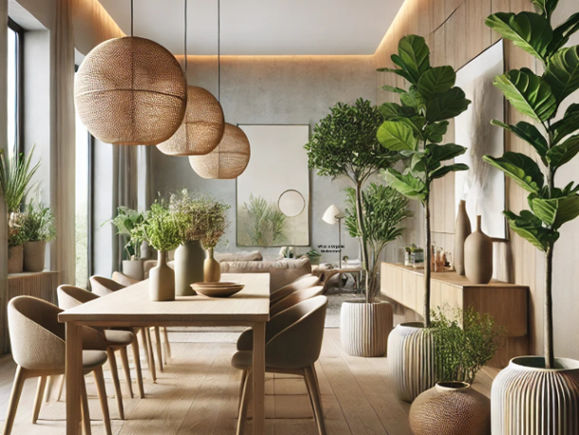Organic Modernism is an exciting design concept that combines natural elements with modern aesthetics. It is more than a style; it is an entire approach to place-making that feels timeless, serene, and intimately connected to nature. This in-depth article will explore What Is Organic Modernism? truly means, its roots, defining features, and actionable steps to incorporate it into your life.
The Essence of Organic Modernism
An intriguing design idea that blends contemporary aesthetics with natural components is called “Organic Modernism.” It is a whole method of creating a space that seems classic, calm, and closely tied to the natural world, not just a particular style.

Why Is It Called Organic Modernism?
The term “organic” highlights the use of natural materials such as wood, stone, and linen, while “modernism” refers to the sleek, uncluttered design principles that emerged during the 20th century. Together, they form an aesthetic that feels both grounded in nature and forward-thinking in design.
A Brief History of Organic Modernism
Organic Modernism started from the mid-century modern movement, popular in the 1950s and 1960s. Well-known designers like Frank Lloyd Wright, Eero Saarinen, and Alvar Aalto believed that buildings and interiors should blend with nature.
One of the best iconic examples is Wright’s famous “Fallingwater” house. This masterpiece is built over a waterfall and represents the philosophy by seamlessly blending with its environment and using locally sourced materials to minimize its ecological footprint.
Evolution Over Time
While mid-century modernism focused on innovative materials and functional design, Organic Modernism places greater emphasis on sustainability and biophilic design. It reflects society’s growing desire to reconnect with nature in an increasingly urbanized world.
Key Features of Organic Modernism
To fully appreciate Organic Modernism, let’s dive into its defining characteristics:
1. Natural Materials
Natural materials are central to Organic Modernism. These include:
- Wood: Reclaimed wood tables, oak flooring, and walnut cabinetry.
- Stone: Marble countertops, travertine tiles, or slate accents.
- Natural Fibers: Linen curtains, jute rugs, and wool throws.
These materials add warmth, texture, and a connection to the earth.
2. Neutral Colour Palettes
Inspired by nature, Organic Modernism embraces earthy tones such as:
- Soft greys
- Warm beiges
- Earthy browns
- Deep greens
These hues foster a calming and harmonious atmosphere.
3. Clean Lines and Minimalism
Organic Modernism is contemporary in style because it uses simplicity and functionality along with natural elements. There is no clutter, and everything serves a purpose.
4. Indoor-Outdoor Connection
One of the main aspects of Organic Modernism is how well indoor and outdoor spaces work together. Big windows, sliding glass doors, and indoor plants all help bring nature inside in a smooth way.
5. Sustainability
Sustainability is an important part of this design idea. It encourages using eco-friendly methods like recycling materials, buying energy-efficient appliances, and choosing strong, good-quality furniture.

Why Is Organic Modernism Gaining Popularity?
In today’s fast-paced world, people are seeking simplicity and a deeper connection to nature. Organic Modernism offers a serene and functional escape from the chaos of modern life.
The Biophilic Impact
A study conducted by Harvard University revealed that biophilic design—a concept closely tied to Organic Modernism—can significantly reduce stress and enhance focus. This makes it an appealing choice for homes and workplaces alike.
How to Incorporate Organic Modernism in Your Home
Inspired to embrace this design philosophy? Follow this step-by-step guide to transform your home:
Step 1: Start with a Neutral Base
Select a neutral color palette for your walls, floors, and large furniture parts. This creates a calm and cohesive foundation for the space.
Step 2: Introduce Natural Materials
Integrate natural materials through furniture, flooring, and decor. Examples include:
- A live-edge wooden dining table.
- Stone countertops or accent walls.
- Linen or cotton throws for added texture.
Step 3: Add Greenery
Plants are a simple yet transformative way to enhance Organic Modernism. Consider:
- A tall fiddle-leaf fig for dramatic effect.
- A variety of succulents are arranged on shelves or tables.
- Hanging planters to maximize vertical space.
Step 4: Embrace Minimalism
Clear the room and bring in the crème de la crème, multi-tasking furniture. A storage ottoman can be used as a seat and hide cluttered items.
Step 5: Layer Soft Lighting
Lighting is very important to create the right mood. Use natural light with warm-colored LED lights, and incorporate eye-catching fixtures made from natural materials such as rattan or ceramic.
Step 6: Incorporate Vintage and Modern Elements
Blend vintage pieces with contemporary designs for a dynamic yet cohesive look. For example, pair a mid-century new armchair with a rural wooden coffee table.
Where to Shop for Organic Modernism
Here are some retailers that cater to this design style:
- West Elm: Known for modern furniture with natural elements.
- Etsy: A hub for handmade and vintage items.
- CB2: Offers sleek, minimalist designs with an organic twist.
FAQs About Organic Modernism
1. What is the difference between Organic Modernism and mid-century modern?
Organic Modernism is much more functional and has cleaner lines than mid-century modern with a strong focus on natural materials, sustainability, and an easy indoor-outdoor connection. The mid-century modern style tends to emphasize industrial material innovations and bright colors.
2. Can Organic Modernism work in small spaces?
Sure! Simple Organic Modernism ideas are amazing for small spaces. Select furniture that can do more than one thing, neutral colors, and a lot of natural light make the space feel open.
3. Is Organic Modernism expensive to implement?
Good natural materials can be very pricey, but there are cheaper ways to get the look. Think about using reclaimed wood, buying second-hand items, or doing DIY projects with sustainable materials.
4. What types of plants work best for Organic Modernism?
Low-maintenance plants like fiddle-leaf figs, monstera deliciosa, and snake plants work beautifully. These plants not only add greenery but also enhance the overall aesthetic with their sculptural shapes.
5. How can I make my home more sustainable with Organic Modernism?
- Use energy-efficient appliances.
- Opt for durable, eco-friendly materials.
- Incorporate solar lighting or LED fixtures.
- Choose local or sustainably sourced furniture.
6. Can I mix other styles with Organic Modernism?
Yes! Organic Modernism is versatile and pairs well with styles like Scandinavian, industrial, or even traditional decor. The key is to maintain a balance and avoid overcrowding the space.
Final Thoughts
Organic Modernism transcends trends by offering a timeless and sustainable approach to design. Its emphasis on natural materials, clean lines, and biophilic principles fosters spaces that are both stylish and nurturing.
By incorporating elements of Organic Modernism into your home, you can create a sanctuary that reflects both your style and a deeper connection to the natural world. So, why wait? Start your journey towards a more harmonious living space today.